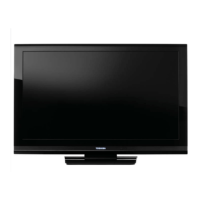
Do you have a question about the Toshiba 40RV525U and is the answer not in the manual?
| Power supply type | AC |
|---|---|
| Package depth | 224 mm |
| Package width | 1247 mm |
| Package height | 777 mm |
| Package weight | 22816 g |
| Child lock | No |
| Plug and Play | Yes |
| Response time | 8 ms |
| Display diagonal | 40 \ |
| Display technology | LCD |
| Native aspect ratio | 16:9 |
| Supported video modes | 1080p |
| Supported graphics resolutions | 1920 x 1080 (HD 1080) |
| HDMI ports quantity | 3 |
| SCART ports quantity | 0 |
| USB 2.0 ports quantity | USB 2.0 ports have a data transmission speed of 480 Mbps, and are backwards compatible with USB 1.1 ports. You can connect all kinds of peripheral devices to them. |
| Digital audio optical out | 1 |
| Component video (YPbPr/YCbCr) in | 2 |
| Product color | Black |
| LED indicators | Stand-by |
| Panel mounting interface | 400 x 300 mm |
| Sustainability certificates | ENERGY STAR |
| Tuner type | Analog & digital |
| Analog signal format system | NTSC |
| Digital signal format system | ATSC |
| Depth (with stand) | 277 mm |
|---|---|
| Width (with stand) | 998 mm |
| Height (with stand) | 683 mm |
| Weight (with stand) | 19096 g |
| Depth (without stand) | 97 mm |
| Height (without stand) | 635 mm |
Lists the key features of the new Toshiba LCD TV.
Guides users through the essential steps for setting up and using their new TV.
Identifies and explains the controls and connectors on the front and side panels of the TV.
Details the various input and output terminals located on the back panel of the TV.
Describes common audio/video cable types used for connecting devices to the TV.
Provides instructions for connecting VCRs, DVD players, and satellite receivers to the TV.
Guides users on connecting HDMI, DVI, and PC devices to the TV's respective inputs.
Explains HDMI control setup and connecting digital audio systems.
Covers installing batteries, effective range, and initial remote control setup.
Details the functions of various buttons on the TV remote control.
Guides on using the remote to operate external devices like VCRs, DVD players, etc.
Step-by-step instructions for programming the remote to control non-Toshiba devices.
Provides an overview of the TV's main menu structure and options.
Details the layout of the Setup and Installation menus.
Explains how to navigate through the TV's on-screen menu system.
Covers menu language, logo settings, and antenna input configuration.
Instructions for programming channels and labeling them for easy identification.
Configures HDMI audio modes and views system status information.
Restores all TV settings and channels to their original factory values.
Guides on how to choose which connected device's input to display on the TV screen.
Introduces the Channel Browser for navigating channels and inputs.
Options for adjusting the TV screen's aspect ratio and fine-tuning picture quality.
Covers closed captions, stereo/SAP broadcasts, and audio quality adjustments.
Manages parental controls, channel blocking, and input locks.
Enables HDMI control and adjusts PC input settings for optimal display.
Adjusts dynamic contrast, static gamma, and color temperature for better picture detail.
Optimizes TV settings for video games by reducing input lag.
Configures advanced audio features like QSound for enhanced sound.
Provides initial steps and common solutions for various TV issues.
Addresses problems like black screens, poor color, noisy pictures, and sync issues.
Covers problems with sound, unresponsive controls, and TV power.
Solutions for issues related to tuning or finding TV channels.
Lists the technical specifications of the TV, including dimensions and power requirements.
Details the signal formats supported by the PC IN and HDMI input terminals.
Outlines the warranty terms and conditions for US customers.
Details the warranty terms and conditions for Canadian customers.
Provides legal disclaimers regarding warranty, liability, and dispute resolution.
